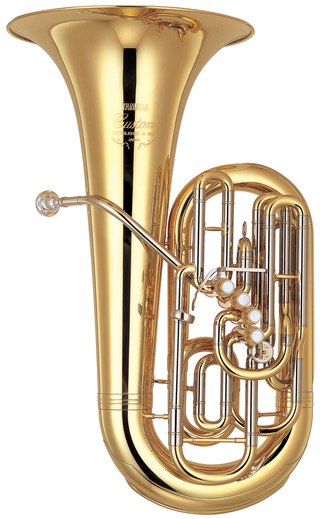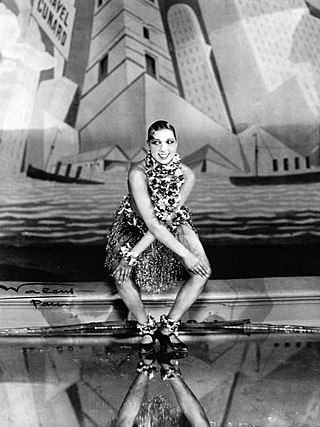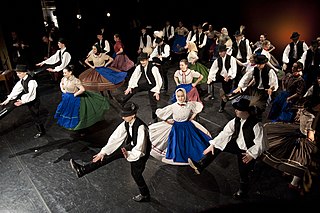
The tuba is the largest and lowest-pitched musical instrument in the brass family. As with all brass instruments, the sound is produced by lip vibration – a buzz – into a mouthpiece. It first appeared in the mid-19th century, making it one of the newer instruments in the modern orchestra and concert band, and largely replaced the ophicleide. Tuba is Latin for "trumpet".

Irish dance refers to a group of traditional dance forms that originate in Ireland, encompassing dancing both solo and in groups, and dancing for social, competitive, and performance purposes. Irish dance in its current form developed from various influences such as earlier native Irish dance, English country dancing and later possibly French quadrilles, as it became popular in Britain and Ireland during the 19th century. Dance was taught by "travelling dance masters" across Ireland in the 17th and 18th centuries, and separate dance forms developed according to regional practice and differing purposes. Irish dance became a significant part of Irish culture, particularly for Irish nationalist movements. From the early 20th century, a number of organisations promoted and codified the various forms of dance, creating competitive structures and standardised styles. Irish dancers who compete for competitive reasons dance in a dance style that is more modern than traditional Irish dance. It is mainly done solo, but there is some team dancing in groups of 2, 3, 4, 6, 8, 10, 16 and even numbers onwards.

The Charleston is a dance named after the harbor city of Charleston, South Carolina. The rhythm was popularized in mainstream dance music in the United States by a 1923 tune called "The Charleston" by composer/pianist James P. Johnson, which originated in the Broadway show Runnin' Wild and became one of the most popular hits of the decade. Runnin' Wild ran from 28 October 1923 through 28 June 1924. The Charleston dance's peak popularity occurred from mid-1926 to 1927.
Because ballet became formalized in France, a significant part of ballet terminology is in the French language.
Irish set dancing, sometimes called "Irish sets", is a popular form of folk dancing in Ireland danced to Irish tunes in groups of eight or four dancers. It is also sometime named set dance, but this name refers more often to a kind of dance in Irish stepdance.

A ballet dancer is a person who practices the art of classical ballet. Both females and males can practice ballet. They rely on years of extensive training and proper technique to become a part of a professional ballet company. Ballet dancers are at a high risk of injury due to the demanding technique of ballet.
Clogging, buck dancing, or flatfoot dancing is a type of folk dance practiced in the United States, in which the dancer's footwear is used percussively by striking the heel, the toe, or both against a floor or each other to create audible rhythms, usually to the downbeat with the heel keeping the rhythm.

The E-flat clarinet is a member of the clarinet family, smaller than the more common B♭ clarinet and pitched a perfect fourth higher. It is typically considered the sopranino or piccolo member of the clarinet family and is a transposing instrument in E♭ with a sounding pitch a minor third higher than written. In Italian it is sometimes referred to as a terzino and is generally listed in B♭-based scores as terzino in Mi♭. The E-flat clarinet has a total length of about 49 cm.

Baton twirling is a sport that combines dance and color guard to create coordinated routines. It requires a "baton" which is metal rod, typically just slightly larger than one's dominant arm. The sport can be seen in national and international competitions including the USA Junior Olympics.

Irish stepdance is a style of performance dance with its roots in traditional Irish dance. It is generally characterized by a stiff upper body and fast and precise movements of the feet. It can be performed solo or in groups. Aside from public dance performances, there are also stepdance competitions all over the world. These competitions are often called Feiseanna. In Irish dance culture, a Feis is a traditional Gaelic arts and culture festival. Costumes are considered important for stage presence in competition and performance Irish stepdance. In many cases, costumes are sold at high prices and can even be custom made. Each costume is different, with varying colors and patterns, designed to attract the judge's eye in competitions and the audience's eye in performance. General appearance beside the costume is also equally important. Female dancers would typically curl their hair before each competition or wear curled wigs, while male dancers would neatly style their hair to a shape to their liking. Poodle Socks are worn by female dancers while males wear plain black socks. Poodle socks are white socks that stretch to typically 1-4 inches above the ankle, depending on the dancers preference. They also have distinctive ribbing, and can be embroidered with gems.

Hungarian dance refers to the folk dances practised and performed by the Hungarians, both amongst the populations native to Hungary and its neighbours, and also amongst the Hungarian diaspora.
A solo concerto is a musical form which features a single solo instrument with the melody line, accompanied by an orchestra. Traditionally, there are three movements in a solo concerto, consisting of a fast section, a slow and lyrical section, and then another fast section. However, there are many examples of concertos that do not conform to this plan.

In ballet, a grand pas is a suite of dances that serves as a showpiece for lead dancers, demi-soloists, and in some cases the corps de ballet. It usually consists of an entrée (introduction), a grand adage, sometimes a dance for the corps de ballet, optional variations for the demi-soloists, variations for the lead ballerina or danseur or both, and a coda, which concludes the suite.

Irish traditional music is a genre of folk music that developed in Ireland.
Traditional Irish singing is the singing of traditional songs in the native styles such as sean nós. Though some people consider sean nós to particularly refer to singing in the Irish language, the term 'traditional singing' is more universally understood to encompass singing in any language, as well as lilting.
Sean-nós dance in America has its roots in Irish culture, but may be practiced differently from how it is danced in Ireland. When Irish people emigrated to America in great numbers during the early American Colonial period, or when escaping The Troubles in Ireland, they brought their dance culture with them. One of the many forms of Irish dance is sean-nós dance, which is an informal, spontaneous, solo form of dance. Sean-nós dance has both modified, and in turn been modified by, similar forms of traditional vernacular solo dance in America.
Sean-nós dance is an older style of traditional solo Irish dance. It is a casual dance form, as opposed to the more formal and competition-oriented form of Irish stepdance.
Sean-nós singing is unaccompanied, traditional Irish vocal music usually performed in the Irish language. Sean-nós singing usually involves very long melodic phrases with highly ornamented and melismatic melodic lines, differing greatly from traditional folk singing elsewhere in Ireland, although there is significant regional variation within Ireland. Sean-nós songs cover a range of genres, from love song to lament to lullaby, traditionally with a strong focus on conveying the relevant emotion of the given song. The term sean-nós, which simply means "in the old way", is a vague term that can also refer to various other traditional activities, musical and non-musical.
So You Think You Can Dance is an American television reality program and dance competition airing on the Fox Broadcasting Company network. Season seven premiered on May 27, 2010. In the August 12 finale, contemporary/jazz dancer Lauren Froderman was named "America's Favorite Dancer" and received the grand prize of $250,000, as well as an appearance on the cover of Dance Spirit magazine and in print advertising for Gatorade. Contemporary dancer Kent Boyd was named runner-up.









